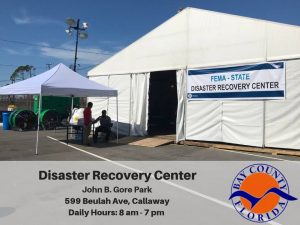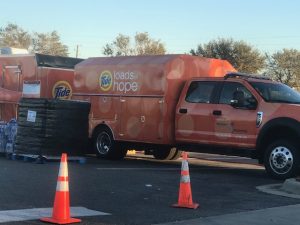Where to put the nearly 10,000 residents displaced?
While the statistics are improving on the progress in Hurricane Michael recovery efforts, one of the biggest challenges in the aftermath remains largely unanswered: where can displaced residents live for the next few weeks and months as homes and businesses and needed infrastructure are rebuilt?

One of 13 Disaster Recovery Centers in the Florida panhandle
The Florida death toll is now 35 people, power is still out to 2,300 homes and businesses as of late yesterday (down from about 400,000 after the storm), there are boil water notices in parts of five counties, and six shelters remain open housing 528 people. 90% of cell service is back up, as the Florida Department of Management Services’ Division of Telecommunications has deployed more than 100 public safety mobile communications trailers and towers, mobile cell towers, hot-spots and Mi-Fi’s, as well as more than 1,050 public safety portable radios, 10,000 cellular devices and 30 charging stations. Verizon, a target of criticism over outages, has announced it will spend $25 million to upgrade its Florida network. Gulf County schools move to a full-day schedule today, but 19 Bay County public schools remain closed. All courts in the region as well as the FSU Panama City campus have reopened.
Today, 13 Disaster Recovery Centers (DRCs) are open across 10 counties, where impacted residents can go for information about disaster assistance programs, and to ask questions about individual assistance applications. Representatives from the Florida Department of Emergency Management, FEMA, U.S. Small Business Administration (SBA), volunteer groups and other agencies are at these centers to answer questions about disaster assistance and low-interest disaster loans for homeowners, renters and businesses. They can also help survivors apply for federal disaster assistance. To date, FEMA has approved more than $85 million in Individual Assistance.

A familiar icon: The Tide detergent vans provide residents mobile clothes washers on one side and dryers on the other and tables to fold clothes.
The fact remains though that many people impacted by Hurricane Michael have no place to go. That’s especially true for renters and those in public housing, damaged by the storm. The limited number of hotels in northwest Florida are full and as we already mentioned, any remaining trailers and RVs have been taken. An estimated 10,000 to 20,000 panhandle residents lost their homes in the storm; those who need temporary housing number 7,500 to 10,000.
Florida’s congressional delegation and legislative leaders last week asked FEMA to immediately deploy their iconic “FEMA trailers”, mobile homes, and RVs to alleviate the misery. FEMA is quoted in news reports as saying that will be a “last ditch option down the road” and will be made by local and state officials.
For those with livable homes and electricity, there’s one bright spot, literally: electric bills have been suspended for customers of Duke Energy and Florida Public Utilities Company (FPU). FPU is also seeking state approval for a program where the utility would pay upfront costs for electrical repairs to homes and then recoup the money from the customers over the following year. It estimates up to 1,200 of its 13,000 customers can’t be reconnected because of damage to electrical equipment that is the customer’s responsibility.

